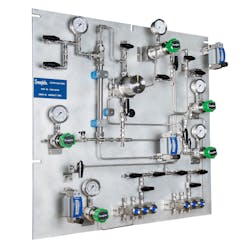Tips for choosing proper industrial fluid system valves

When designing and maintaining industrial, piping and instrumentation systems, valves are some of the most crucial components to get right to ensure proper performance. Improper valve selection could lead to problems ranging from avoidable safety risks to poor performance and even increased downtime.
Typically, valves are some of the first components selected when system designers begin their work. Then, as the valves wear out, maintenance technicians will usually replace them with the same model as the original specification to retain continuity and ensure proper function. When viewed from this perspective, it is evident that choosing the right valve at the time of the initial system setup is crucial.
Fortunately, the STAMPED method — which stands for Size, Temperature, Application, Media, Pressure, Ends (or fittings) and Delivery — can provide a framework that can help designers and technicians select the proper valve every time.
S: Size
Before deciding what size a valve should be, operators must decide what desired (or required) flow rate is necessary for a system to work as intended. Once that is determined, operators should choose a valve with a flow capacity that makes that flow rate possible. It is helpful when suppliers indicate a flow coefficient (Cv) on their products, as that tells operators what the relationship is between the pressure drop across a valve and the resulting flow rate.
Cv represents how much water, in U.S. gallons per minute, will move through a valve with a 1 psi pressure drop across it at a temperature of 60°F. In situations in which compressible fluids, like gases, are moving through the pipes, the calculation becomes more complicated but is still useful in understanding what size valve is right for particular applications.
How a valve is designed can affect its Cv. The size and geometry of the valve, for example, can influence the flow path, while the size of the orifice will determine how much fluid can flow through it. Larger orifices increase the potential flow path, but orifice sizes can vary depending on the type of valve used. A ball valve may provide minimal flow resistance, but a needle valve may restrict or slow down the flow. Variances like these should influence which valve is chosen for specific applications.
If there is any question which valve is right, a reputable supplier should be able to guide you toward the right-sized valve for the situation. In fact, some even offer a Cv calculator to begin the process of choosing the right valve.
T: Temperature
Another crucial factor to consider when specifying a valve is the temperature in which it will be operating, including both the temperature of the media the valve will control as well as the ambient operating temperature of the environment. Whether these will be constant or change frequently may inform your decision on which valve to select, as well as influence how often you should inspect the valve for maintenance or replacement.
Temperature fluctuations may result in the expansion and contraction of seals, causing rapid wear that may lead to failures and leaks. In addition, the valve’s metal construction may not be as strong at elevated temperatures, which could lower pressure ratings for specific valves. Suppliers should be able to offer specific test results that indicate the valves under consideration have been tested at temperature extremes to ensure they will work properly.
A: Application
As always, operators should consider the specific function a valve will need to perform within the system. Will it start or stop flow, or will it regulate flow levels instead? Will it be necessary for the valve to control the direction of the flow or keep the system from overpressurizing? The answers to these questions will help determine which valve is right for specific applications.
For example, take a two-way ball valve. Some ball valves may allow you to throttle the fluid as it flows through the valve, but most do not. Instead, they are designed to either be fully opened or fully closed. If the intention is to throttle or regulate flow, it makes more sense to use a needle or metering valve instead.
M: Media
It is important to understand what effect the fluid running through the system will have on the valves and choose the right materials accordingly. Compatibility is key, and the valves should be constructed of materials that work with the valve bodies, seats, stem tips and other softer materials. If the components are made of incompatible materials, it can lead to corrosion, embrittlement or cracking, which could put operators at risk or require significant downtime.
In addition to being compatible with each other, valves should be chosen to be compatible with the environments in which they will operate. The question of whether the valve will be used in a climate-controlled environment, or whether it will be outside in direct sunlight, rain, snow, frost, ice and/or fluctuating temperatures is important. For example, the valve might be used in a marine environment and thus be exposed frequently to chlorides, requiring it to be made from a higher-grade stainless steel or other material. Since valves are made from a variety of materials, selecting ones that will stand up to the expected operating conditions is paramount to ensuring the valves last as long as intended.
P: Pressure
Designers and operators should also think about how much pressure the valve will be under in specific applications. There are two different meanings of the term depending on how it is used. They are:
- Working pressure: The normal operating pressure in your system.
- Design pressure: The valve’s manufacturer-provided maximum pressure limit; never exceed the design pressure of any fluid system component, unless doing so under controlled testing conditions.
Pressure limitations are determined by the lowest-rated component in a system, of which valves may represent a significant part. As with temperature, fluctuating pressures can have significant effects on how well the component will perform. When selecting a valve, consider whether the valve is designed to operate under a range of temperatures and pressures to ensure the valve selected will stand up to rigorous operating conditions. Once again, designers and operators should carefully consider the material selection and validation before picking a valve. Increased temperatures of the process fluid will lower the working pressures of the system.
E: End Connections
End connections vary as much as the type of valves themselves. Whether they are integral tube fittings, pipe threads, pipe flanges, welded ends or other options, end connections are crucial to how well a valve will resist leaking. Choosing valves with the appropriate end connections for the pressure, temperature, and size of a system will make the valves easier to install and prevent the addition of unnecessary leak points.
D: Delivery
Finally, once all these factors have been considered, the question remains of how quickly a supplier can deliver the necessary number of valves in time to install them in the system. Finding a supplier that can offer on-time delivery and a reliable valve supply is just as important as any other part of the STAMPED method.
Selecting the right valves is essential to design safe, efficient fluid systems. Using the STAMPED method should offer enough of a framework to get operators headed in the right direction.
Joe Bush is senior product manager for Swagelok. An original version of this article appeared on the Swagelok Reference Point blog.

